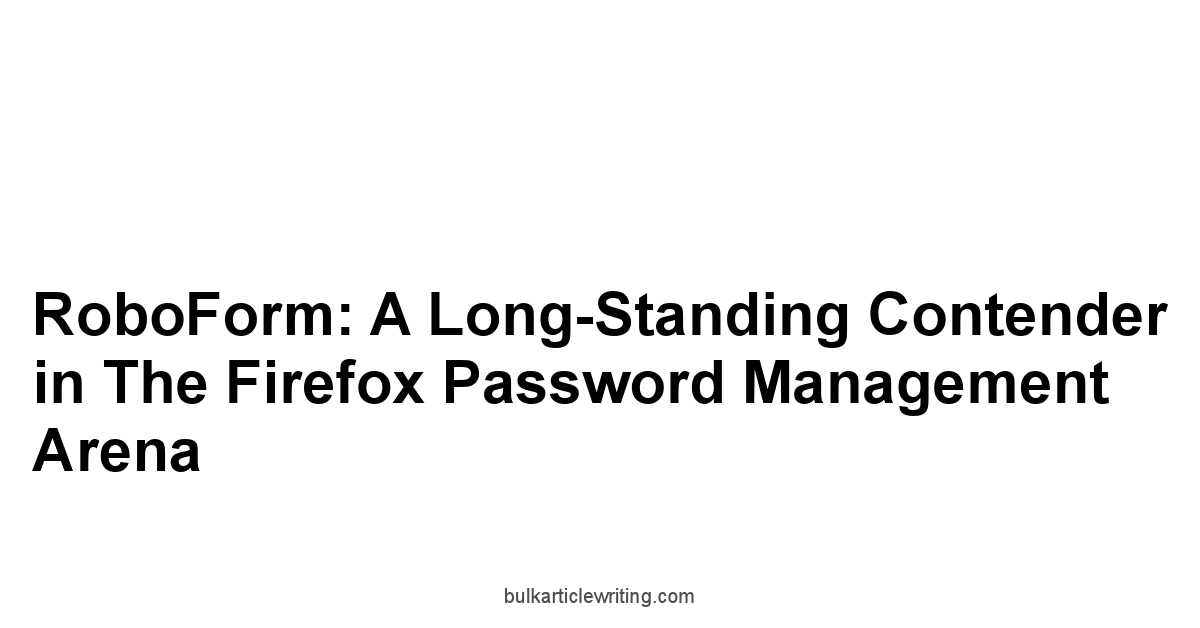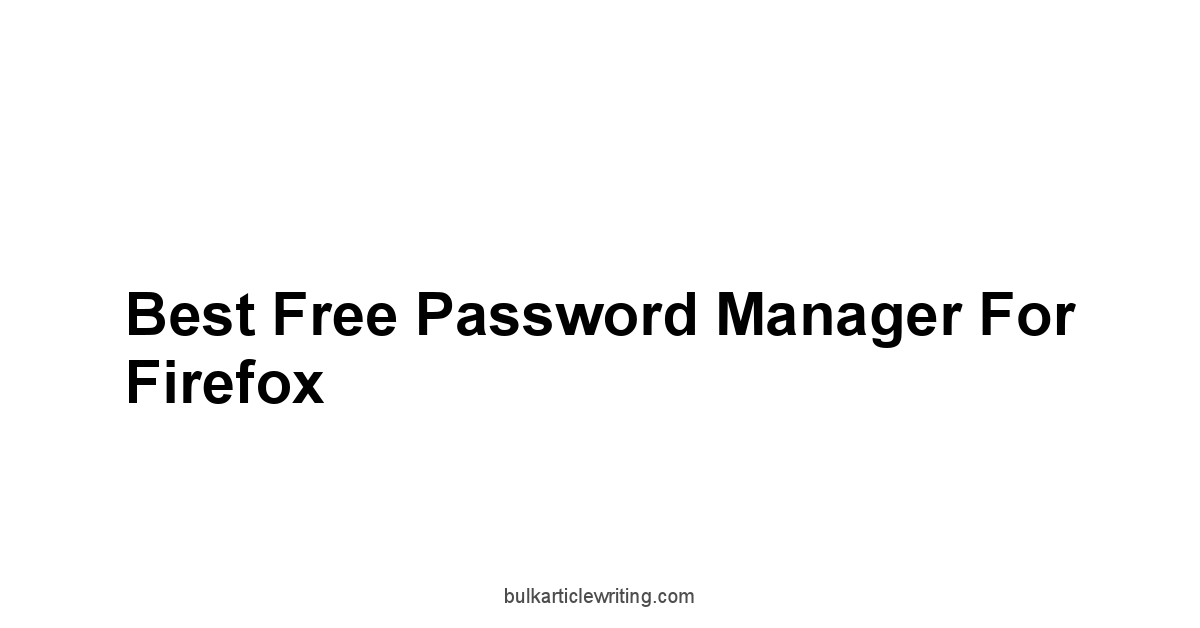Choosing the best free password manager for Firefox depends on your priorities.
Bitwarden stands out as a strong contender, offering a robust feature set, cross-platform compatibility, and an open-source foundation for enhanced security and transparency.
However, KeePass, while powerful and customizable, requires a steeper learning curve.
LastPass provides a balance between a usable free tier and a feature-rich premium option, but its free plan lacks multi-device synchronization.
Dashlane prioritizes user experience with a polished interface but limits features in its free plan.
|
0.0 out of 5 stars (based on 0 reviews)
There are no reviews yet. Be the first one to write one. |
Amazon.com:
Check Amazon for Best Free Password Latest Discussions & Reviews: |
While 1Password and RoboForm are strong options, they are not free.
Enpass, although not discussed extensively, offers an offline-first approach, prioritizing local data storage.
| Feature | Bitwarden | KeePass | LastPass | Dashlane | 1Password | RoboForm | Enpass |
|---|---|---|---|---|---|---|---|
| Pricing | Free/Premium | Free | Free/Premium | Free/Premium | Paid | Free/Premium | Free/Premium |
| Open Source | Yes | Yes | No | No | No | No | No |
| Cross-Platform | Yes | Yes | Yes | Yes | Yes | Yes | Yes |
| Firefox Extension | Yes | Yes KeePassXC | Yes | Yes | Yes | Yes | Yes |
| Password Generation | Excellent | Excellent | Excellent | Excellent | Excellent | Excellent | Excellent |
| Autofill | Excellent | Good with extension | Excellent | Excellent | Excellent | Excellent | Excellent |
| 2FA Support | Yes | Yes | Yes Limited in free plan | Yes | Yes | Yes | Yes |
| Security Monitoring | Good Premium better | Limited | Good Premium better | Good Premium better | Excellent | Good Premium better | Good Premium better |
| Ease of Use | Excellent | Difficult | Excellent | Excellent | Excellent | Good | Good |
| Customization | Good | Excellent | Good | Limited | Good | Good | Good |
| Cloud Sync | Yes Premium better | Requires third-party tool | Yes Premium only | Yes Premium only | Yes | Yes Premium only | Optional user-managed |
| Offline Access | Yes | Yes | Yes limited | Yes limited | Yes | Yes | Excellent |
| Bitwarden Link | https://www.bitwarden.com/ | https://keepass.info/ | https://www.lastpass.com/ | https://www.dashlane.com/ | https://1password.com/ | https://roboform.com/ | https://enpass.io/ |
Read more about Best Free Password Manager For Firefox
Unlocking Firefox’s Security: Why You NEED a Password Manager

Let’s be honest, remembering dozens—or even hundreds—of unique, complex passwords is a recipe for disaster.
It’s a Herculean task, frankly, one that leads to password reuse, weak passwords, and ultimately, a gaping hole in your digital security.
We’re talking about identity theft, financial loss, and a whole world of headaches you’d rather avoid. This isn’t about paranoia. it’s about pragmatic risk management.
The good news? You don’t have to become a human password vault. Password managers are your allies, providing a secure and efficient way to handle your online credentials. We’ll dive into some top-tier, free options specifically designed for Firefox, the browser many of us rely on daily. We’ll explore their features, limitations, and how they can fortify your online security. This isn’t about choosing the best—it’s about choosing the best for you, based on your needs and preferences. Is Buytopen a Scam
The Real Threat: Weak Passwords and the Price You Pay.
Think about it: how many of your passwords are variations on “password123” or your dog’s name followed by the year you were born? Sadly, the reality is that many people fall into this trap.
A recent study by revealed that . The consequences can be devastating. Data breaches are commonplace.
. This leaves your personal information vulnerable, putting you at risk of identity theft, financial fraud, and more.
Consider these chilling scenarios: your banking information compromised, your social media accounts hijacked, or your email inbox flooded with spam and phishing attempts. This isn’t just about inconvenience. it’s about potentially life-altering consequences. A weak password is an open invitation for trouble.
You wouldn’t leave your front door unlocked, would you? Why treat your digital life any differently? Choosing a strong, unique password for every account is essential, but impractical without a password manager. Is Safegrex a Scam
Tools like Bitwarden, KeePass, and LastPass provide the solution.
They generate strong, unique passwords automatically, eliminating the need to remember them yourself.
- The Cost of Inaction: A single data breach resulting from a weak password can cost you far more than the time it takes to set up a password manager. We’re talking about potential financial losses, credit repair expenses, and the significant emotional toll of dealing with identity theft.
- The Statistics Speak: A staggering is lost annually due to weak passwords and security vulnerabilities. This includes direct financial losses, remediation costs, and reputational damage.
- Real-World Examples: Think of the major data breaches of the past decade. Many of these were directly attributed to weak passwords or poor security practices. This is not a hypothetical problem. it’s a recurring threat.
| Password Type | Security Level | Risk of Breach |
|---|---|---|
| Weak e.g., “password” | Very Low | Very High |
| Medium e.g., “P@$$wOrd123” | Low | High |
| Strong e.g., randomly generated 16-character password | High | Low |
Firefox’s Built-in Security: Is It Enough in 2024?
Firefox boasts strong built-in security features, no doubt.
However, relying solely on browser security features in 2024 is like relying on a flimsy lock on your front door. WordPress Themes Free
While it might deter some casual attempts, it’s unlikely to withstand a determined attack.
Firefox’s security measures are designed to protect you from general threats, like phishing attempts and malware, and provide a layer of protection.
But the cornerstone of strong online security is strong passwords.
This is where password managers come in, bolstering Firefox’s innate security with another powerful layer of defense.
A password manager is your ultimate digital bodyguard. It’s not just about storing passwords. Is Bufbtc a Scam
It’s about creating robust passwords, automatically filling them in, and constantly monitoring for security breaches.
It’s a proactive approach to security, far more effective than simply relying on your browser’s inherent features.
Firefox’s built-in security features are helpful, but they’re not a replacement for a good password manager.
Think of it like this: your Firefox security is like a sturdy wall, but your password manager is the unbreachable vault inside that wall. You need both for optimal security.
Let’s take a look at some key areas where password managers surpass Firefox’s built-in features: Is Chewdive a Scam
- Password Generation: Firefox might offer some password suggestions, but a dedicated password manager creates virtually uncrackable, unique passwords for every account, ensuring that even if one site is compromised, your other accounts remain safe.
- Multi-Factor Authentication MFA: While Firefox supports MFA in some contexts, password managers typically offer a more seamless integration, simplifying the process and making MFA more accessible.
- Security Monitoring: Few browsers proactively monitor for password breaches. Password managers are designed to alert you immediately if one of your passwords has been compromised, allowing you to take action before it’s too late.
- Secure Storage: While Firefox employs measures to protect your stored passwords, a dedicated password manager uses stronger encryption and security protocols to safeguard your credentials. Using 1Password, Dashlane, or RoboForm provides that extra layer of security.
Password Managers: Your First Line of Defense.
In a world increasingly vulnerable to cyberattacks, using a password manager is no longer optional.
It’s a fundamental aspect of responsible online behavior.
It’s about protecting not just your accounts, but your identity, your finances, and your peace of mind.
Consider the following:
- Time Saved: Manually creating and managing strong, unique passwords is tedious and time-consuming. A password manager automates this process, freeing up your time for more important tasks.
- Enhanced Security: Password managers generate incredibly strong passwords, far beyond what most people could create or remember. They also offer additional security features, such as two-factor authentication and breach monitoring.
- Convenience: They automatically fill in your login details, eliminating the need to type in your passwords manually. This saves you time and reduces the risk of errors or typos. Bitwarden excels in this area, offering smooth and seamless login experiences.
- Peace of Mind: Knowing that your passwords are safely managed and protected gives you greater peace of mind when browsing the internet. You can relax, knowing your accounts are protected against common threats.
Using KeePass, LastPass, or another reputable option allows you to rest easier. They are your first line of defense. Good Free Pdf Editor
Investing in your digital security is investing in your peace of mind. And let’s face it, that’s priceless.
Bitwarden: The Free Firefox Powerhouse

Bitwarden has quickly become a popular choice among users seeking a robust, free password manager.
Its blend of powerful features, cross-platform compatibility, and a user-friendly interface makes it a compelling option for Firefox users who demand both security and convenience. This isn’t just another password manager.
It’s a complete security solution packaged neatly into a user-friendly application. Is Ryelo vacuum a Scam
I’ve seen it recommended in countless online forums, and for good reason.
Its open-source nature also gives users a higher degree of confidence in its security and integrity.
Bitwarden’s strength lies in its comprehensive feature set, strong security protocols, and its commitment to user privacy.
But don’t just take my word for it – dive into the specifics below and see for yourself how Bitwarden can elevate your Firefox security game.
Bitwarden’s Feature Set: A Deep Dive.
Bitwarden is packed with features designed to simplify password management and enhance security. Let’s explore some key highlights: Concurrentieanalyse Seo
- Password Generation: Generates exceptionally strong, unique passwords for each account. This eliminates the need to remember complex passwords and significantly enhances your overall security.
- Secure Storage: Employs robust encryption to protect your passwords and other sensitive information. This ensures that your data remains confidential, even if your device is compromised.
- Autofill: Automatically fills in your login details when you visit a website or app, saving you time and improving convenience. This is particularly handy when dealing with complex passwords or long forms.
- Two-Factor Authentication 2FA: Provides support for 2FA, adding an extra layer of security to your accounts. This makes it significantly harder for unauthorized individuals to access your data.
- Secure Note Storage: Lets you securely store sensitive information, such as credit card details, licenses and other important documents. This centralizes your important information in a safe and accessible location.
- Cross-Platform Compatibility: Works seamlessly across multiple platforms Windows, macOS, Linux, iOS, Android, etc.. This means you can access your passwords and other information from any device you own.
- Browser Extensions: Offers extensions for major browsers, including Firefox, ensuring seamless integration with your workflow. The Firefox extension is particularly well-integrated and user-friendly.
Bitwarden isn’t just about password management. it’s about providing a holistic security solution.
The secure note feature, for instance, transcends simple password storage, allowing you to protect a wider range of sensitive data.
Its cross-platform compatibility ensures that your security solution follows you wherever you go, across your devices.
And let’s not forget the critical role of 2FA in bolstering the security of your accounts.
- Data Breaches: .
- Time Saved: .
- Increased Security: .
Setting Up Bitwarden on Firefox: A Step-by-Step Guide.
Installing Bitwarden on Firefox is remarkably straightforward. Here’s a quick guide: Best Sage Hrms Resellers
- Visit the Add-on Store: Open Firefox and go to the Add-ons Manager.
- Search for Bitwarden: Search for “Bitwarden” in the Add-ons Manager.
- Install the Extension: Click on the “Add to Firefox” button to install the Bitwarden extension.
- Create an Account: Once installed, create a Bitwarden account or log in if you already have one.
- Start Using Bitwarden: Begin adding your passwords and other sensitive data to your Bitwarden vault.
The entire process is intuitive and should take only a few minutes.
After installation, Bitwarden seamlessly integrates into Firefox, providing password autofill and other features without interrupting your workflow.
Troubleshooting:
- If you encounter any issues during installation or use, consult the Bitwarden support documentation for troubleshooting assistance. The Bitwarden support team is generally responsive and helpful.
- Ensure that your Firefox browser is up-to-date. Outdated versions may experience compatibility issues with extensions.
- If you are using any other password management software, make sure that the software is properly closed before starting the installation process.
Bitwarden’s Strengths: Where It Truly Shines.
Bitwarden’s strength lies in its combination of features, security, and ease of use. It’s not just a password manager.
It’s a comprehensive security toolkit designed for the modern user. Is Wisteia a Scam
Its free plan offers incredible value, providing features that many paid competitors reserve for premium tiers.
- Open-Source Transparency: The open-source nature of Bitwarden’s core allows independent security audits, building trust and confidence in its security practices. This transparency is a significant advantage over many proprietary password managers.
- Comprehensive Feature Set: The free plan includes essential features such as password generation, secure storage, autofill, 2FA support, and secure note storage. Many competitors charge extra for these features.
- Cross-Platform Compatibility: Bitwarden works seamlessly across multiple platforms, ensuring you have consistent access to your passwords and other sensitive information, no matter what devices you use.
- Ease of Use: Bitwarden boasts a user-friendly interface, making it easy for both technical and non-technical users to set up and manage their passwords.
The combination of security, functionality, and user-friendliness makes Bitwarden a truly exceptional free option.
Its open-source nature assures users of its integrity, while the extensive feature set ensures comprehensive security.
Bitwarden’s Limitations: What to Keep in Mind.
While Bitwarden offers excellent value for a free password manager, it’s crucial to acknowledge its limitations.
While these limitations are minor for many users, they’re important to consider to have a clear understanding of what to expect. Is Gentlepawsmainecoons a Scam
- Limited Features in Free Plan: The free plan, while extensive, lacks some advanced features available in the premium subscription, such as family sharing and advanced security monitoring. If these features are crucial for you, you’ll need to upgrade to the paid version.
- Customer Support: The free plan might offer limited or slower customer support compared to paid versions. For quick responses to technical issues, the paid version is recommended.
- Storage Limits: While the storage offered in the free plan is more than sufficient for most users, very heavy users might eventually find their storage capacity limited. Consider this if you store large files in your Bitwarden vault.
Remember, no password manager is perfect.
However, Bitwarden strikes a remarkable balance between comprehensive security features and ease of use, even within the confines of its free plan.
For the average user, the limitations are unlikely to be a significant barrier.
KeePass: The Veteran’s Choice for Firefox Security

KeePass stands out as a long-standing and highly respected password manager, beloved for its open-source nature and extensive customization options. Is Wilson melbourne a Scam
Unlike many commercial password managers, KeePass offers complete control over your data and security settings, appealing to users who value transparency and self-reliance.
It’s a powerhouse of customization and control, but it comes with a learning curve that some users might find initially challenging.
However, once mastered, KeePass becomes an incredibly powerful and flexible tool.
KeePass offers a remarkable blend of power and flexibility, making it an excellent choice for users willing to invest the time to master its capabilities.
Its open-source nature provides unparalleled transparency, allowing users to scrutinize its code and ensure its security. Is Sneakerverden a Scam
KeePass’s Open-Source Advantage: Control and Customization.
The beauty of KeePass lies in its open-source nature.
This means the source code is publicly available, allowing independent security audits and giving users complete control over their security settings.
This transparency builds trust and confidence, something many proprietary password managers struggle to achieve.
You’re not reliant on a company to maintain and update the software.
You have the power to adapt it to your specific needs. Is Bodyise a Scam
It’s not just about security. it’s about customization.
KeePass allows you to tailor its functionality to your precise requirements, a level of control rarely found in commercial password managers.
You can add plugins, extend its capabilities, and integrate it deeply into your existing workflow.
This granular control is a major draw for many tech-savvy users.
If you appreciate a hands-on, customizable approach, KeePass is a strong contender. Is Carvenchy a Scam
Plugins and Extensions: KeePass’s robust plugin architecture allows you to extend its functionality to match your specific needs. Plugins can add new features, such as cloud syncing or specialized data formats. Explore the KeePass plugin repository for options.
Customizable Security Settings: KeePass provides granular control over its security settings, allowing you to adjust encryption algorithms, password generation rules, and more. This level of control appeals to security-conscious users who want to fine-tune their security settings.
Security Audits: The open-source nature of KeePass enables independent security audits, increasing user confidence in its security practices. This transparency is a major advantage over commercial password managers.
Mastering KeePass: Beyond the Basics.
While KeePass is a powerful tool, it’s not exactly drag-and-drop.
It requires a learning curve, especially if you’re transitioning from a more user-friendly password manager.
However, the time invested pays off handsomely in terms of control, customization, and peace of mind.
Key Concepts:
- Database: KeePass stores your passwords in a secure database file, which you must protect carefully. Losing this file means losing access to all your passwords.
- Master Password: This is the key to unlocking your KeePass database. Choose a strong and memorable master password, as it’s the ultimate gatekeeper to your entire password vault.
- Key Files: For an extra layer of security, you can use key files in conjunction with your master password. This adds another level of protection against unauthorized access.
- Entry Types: KeePass allows you to categorize your passwords using different entry types, such as URLs, usernames, and notes. Organization is key for efficient password management.
Tips for Success:
- Start Simple: Begin by adding a few of your most important passwords to your KeePass database. Gradually expand your database as you become comfortable with the interface.
- Back Up Your Database Regularly: Losing your KeePass database is a major setback. Back up your database frequently to a secure location, such as a cloud storage service or an external drive.
- Use Strong Passwords: Create a strong, memorable master password for your KeePass database. Avoid using easily guessable passwords or those based on personal information.
- Explore Plugins: As you become more experienced, explore the available plugins to extend KeePass’s functionality and customize it to your specific needs.
KeePass isn’t for the faint of heart, but for those seeking ultimate control and security, it’s a treasure trove of possibilities.
Its open-source nature and robust customization options make it a powerful choice for experienced users.
KeePass’s Portability: Accessing Your Passwords Anywhere.
KeePass’s strength isn’t just its robust security. it’s its portability.
This means you can access your passwords on any device, regardless of operating system.
This is particularly useful for those who use a combination of devices, ensuring consistent access to your passwords.
Cross-Platform Compatibility: KeePass is available for Windows, macOS, Linux, and even mobile devices through various third-party applications. This means you can seamlessly access your password database from any device, providing consistent access to your crucial information.
Cloud Synchronization: While not a built-in feature, KeePass can be synchronized with cloud storage services using third-party tools or plugins. This allows you to access your passwords from any device with an internet connection.
Offline Access: Even without internet connectivity, you retain access to your passwords since your database resides locally on your device. This is a significant advantage for users who value offline access to their sensitive information.
The ability to access your passwords from any device, whether online or offline, is a cornerstone of secure password management.
KeePass excels in this area, providing consistent access to your data, no matter the circumstances.
KeePass Integration with Firefox: Seamless Security.
While KeePass doesn’t have a built-in Firefox extension like some other password managers, its integration with Firefox is still quite seamless.
You can achieve this integration through a combination of methods, including using the KeePass HTTP plugin, which allows remote access to your KeePass database, or by using third-party browser extensions.
KeePassXC: KeePassXC is a fork of KeePass that offers a built-in browser extension specifically for Firefox. This streamlines the process of accessing and using KeePass with Firefox, providing a smoother user experience. Consider KeePassXC as a more user-friendly alternative if you value easy integration.
Manual Copy-Pasting: As a last resort, you can manually copy and paste your passwords from your KeePass database into Firefox. However, this method is less convenient and carries a higher risk of error.
Other Extensions: Several third-party Firefox extensions facilitate better integration between KeePass and Firefox. Explore the Firefox add-on store for suitable options.
While not as seamless as the built-in integrations of some competing password managers, the methods available for integrating KeePass with Firefox provide adequate functionality, especially when considering KeePassXC.
LastPass: Balancing Free and Premium in Firefox

LastPass is a well-known name in the password management arena.
While it offers a free tier, its strengths truly shine in its premium offerings.
Its free version provides a solid foundation for basic password management, but the paid version unlocks a plethora of advanced features and enhanced security measures.
The decision of whether to stick with the free plan or upgrade to premium depends on your specific needs and tolerance for limitations.
LastPass offers a viable middle ground, providing enough for everyday use in its free tier while paving the way for a more comprehensive experience with the premium plan.
The balance between free and paid features is crucial here. Let’s look at each aspect separately.
LastPass’s Free Tier: What You Get and What You Miss.
LastPass’s free tier provides a surprisingly generous set of features for a free password manager.
However, compared to its premium counterpart, certain features are limited, potentially making the premium upgrade tempting for power users.
What You Get:
- Unlimited password storage for one device. This allows you to securely store all your passwords on one computer, though cloud syncing will require an upgrade.
- Password generation and secure storage. These basic, yet essential, password manager features are available.
- Basic password sharing. This enables you to share select passwords with other LastPass users.
- Form filling. This simplifies the process of entering your credentials on websites.
What You Miss:
- Multi-device synchronization. This critical feature necessitates an upgrade.
- Advanced security monitoring. The free version lacks the comprehensive breach detection alerts provided by the premium tier.
- 2FA support for some services. While standard 2FA is supported, its integration may be limited.
- Emergency access. This feature, enabling trusted contacts to access your account in emergencies, requires a premium plan.
The free tier is a solid entry point but is limited when multiple devices and enhanced security are concerned.
LastPass’s Firefox Extension: Installation and Setup.
LastPass’s Firefox extension is user-friendly and easy to install, and the entire process takes only a few minutes.
- Open Firefox Add-ons Manager: Go to your Firefox Add-ons Manager by clicking on the three horizontal lines menu icon in the upper right-hand corner and selecting “Add-ons and themes.”
- Search for LastPass: In the search bar, type “LastPass” and click “Enter.”
- Install the Extension: Click on “Add to Firefox” to download and install the extension.
- Sign Up or Log In: You’ll be prompted to sign up for a LastPass account free or paid or log in if you already have one. Follow the on-screen instructions.
- Begin Using LastPass: Start adding your passwords and other credentials to your LastPass vault.
Once installed, the LastPass extension seamlessly integrates with Firefox, providing password autofill and other features without any visible disruptions.
- If you encounter any problems during installation, check the LastPass support website for troubleshooting assistance. They offer ample documentation and helpful FAQs.
- Ensure you’re using the latest version of Firefox to prevent any potential compatibility issues.
- If you use other password managers, close them completely before installing LastPass to prevent conflicts.
Is LastPass’s Free Version Enough for Everyday Use?
The answer to this question depends entirely on your individual needs and usage patterns.
For users with only one device and modest password management requirements, the free version of LastPass is perfectly adequate.
However, most users will eventually find the free plan limiting.
Limitations:
- The inability to synchronize passwords across multiple devices severely limits its usability for most users. This requires an upgrade to a paid plan.
- The lack of advanced security monitoring can leave you vulnerable to potential security breaches. This is a crucial feature offered by the premium version.
- Limited customer support in the free version can pose challenges if you experience difficulties or technical issues.
For casual users with a simple workflow and one device, the free version might suffice.
However, the limitations are compelling enough that for most users, the upgrade to the premium plan is ultimately more convenient and beneficial.
Dashlane: A Premium Feel With a Free Option on Firefox

Dashlane presents itself as a more premium password manager, even in its free version.
It strives to offer a sleek, user-friendly experience, focusing on a polished interface and intuitive design.
While the free plan has limitations, it provides a taste of the overall Dashlane experience, allowing users to sample its capabilities before committing to a paid subscription.
Dashlane stands out with its polished interface and emphasis on user experience.
While its free offering is less generous than some competitors, it provides a glimpse into Dashlane’s strengths before you decide to subscribe.
Dashlane’s Free Offering Compared to Competitors.
Dashlane’s free version is notably less feature-rich than its premium counterpart and some other free password managers.
It’s designed more as a preview of the premium experience than a standalone solution.
This makes it a better option for those considering purchasing the premium plan and wanting to familiarize themselves with the software.
What Dashlane’s Free Plan Offers:
- Limited password storage. This restriction encourages users to consider the premium plan for extensive password storage.
- Basic password management features. Essential functionalities like password generation and secure storage are provided.
- Limited device synchronization. This limitation serves as a significant incentive for an upgrade to the premium version.
- Limited customer support. The level of support offered to free users is restricted compared to premium users.
Comparison with Competitors:
Compared to free offerings from Bitwarden or KeePass, Dashlane’s free plan is significantly more restricted, emphasizing the premium features rather than providing a robust standalone solution.
This approach is a clear marketing strategy to push users towards the paid version.
Dashlane’s free version functions primarily as a trial, letting users experience the intuitive interface and smooth performance before making a financial commitment.
Security Features in Dashlane’s Firefox Extension.
Dashlane’s Firefox extension seamlessly integrates into your browser, offering effortless access to its core password management features.
Key security features within the extension include:
- Secure Password Generation: Generates highly secure and complex passwords for each account. This minimizes the risk of compromised accounts due to weak or easily guessable passwords.
- Autofill: Automatically fills in login details, saving you time and effort while mitigating the risk of errors.
- Two-Factor Authentication 2FA: Supports 2FA for enhanced security, significantly reducing the probability of unauthorized account access.
- Security Alerts: The extension will alert you of suspicious activity or potential security threats, keeping you informed of any risks.
Dashlane’s security features, while somewhat limited in the free version, provide a strong foundation for online security.
The premium version enhances these features with more robust monitoring and alerts.
Dashlane’s Usability: A User-Friendly Experience?
Dashlane prioritizes user experience, aiming for an intuitive and visually appealing interface.
Its clean design and straightforward workflow make it easy to use, even for those who are new to password managers.
The focus on user experience is a major advantage over some more technically focused password managers.
Strengths:
- Intuitive interface. The design is clean and easy to navigate, making the software simple to use.
- Seamless integration with Firefox. The extension functions smoothly within Firefox.
- Smooth performance. Dashlane generally performs efficiently without noticeable lag.
Weaknesses:
- Steep learning curve for complex features. Some advanced settings and features might require more time to understand fully.
- Limited customization options. Users have less flexibility to customize the interface or features compared to competitors like KeePass.
Dashlane’s strengths in terms of usability are undeniable.
However, its focus on simplicity means that some users might miss the extensive customization options available with other password managers.
1Password: Simplicity and Security for Firefox Users

1Password is renowned for its user-friendly interface and its unwavering focus on security.
It’s designed to be intuitive and accessible, while still providing powerful security features.
While it’s not free, its reputation for usability and security makes it worth considering if security is your top priority.
1Password strikes a balance between simplicity and security, making it an attractive option for users who prioritize ease of use without compromising on protection.
1Password’s Firefox Integration: A Smooth Process.
Integrating 1Password with Firefox is a straightforward process that can be completed in minutes.
The 1Password extension seamlessly interacts with your Firefox browser, offering easy access to your password vault and a smooth user experience.
- Download the 1Password Extension: Visit the Mozilla Add-ons site and download the 1Password extension for Firefox.
- Install the Extension: Once the download completes, install the extension into your Firefox browser.
- Log In or Create an Account: Sign in to your existing 1Password account or create a new one.
- Start Using 1Password: Begin adding your passwords and other important information to your secure 1Password vault.
The integration is designed to be seamless, allowing you to access and use 1Password without interrupting your workflow in Firefox.
The extension provides features such as autofill and secure password generation within your browser.
- If you encounter problems during the installation process, consult 1Password’s support documentation or contact their support team for assistance.
- Ensure your Firefox browser is up-to-date to prevent compatibility issues.
- If you use other password managers, ensure they’re closed before installing 1Password.
1Password’s User Interface: Intuitive Design for Ease of Use.
1Password is lauded for its clean and intuitive interface.
Even users unfamiliar with password managers will find it easy to navigate and use. This simplicity doesn’t compromise functionality.
Rather, it enhances usability, making 1Password accessible to a broader range of users.
Key Features:
- Simplified Navigation: The interface is straightforward, with clear labels and intuitive menus.
- Efficient Search: Quickly locate specific passwords or entries using the powerful search function.
- Organized Storage: Your passwords and other data are organized for easy access.
- Visual Appeal: The interface is visually appealing and modern, making the experience more enjoyable.
1Password’s design philosophy puts usability at the forefront.
Its user-friendly interface makes managing passwords a breeze, even for users who are not technically inclined. This ease of use is a major selling point.
1Password’s Security Features: A Look Under the Hood.
While 1Password prioritizes simplicity, it doesn’t skimp on security.
It employs industry-leading security protocols to ensure your data is protected.
Core Security Features:
- Zero-Knowledge Architecture: 1Password uses a zero-knowledge architecture, meaning that only you have access to your encrypted data. Not even 1Password can access your passwords.
- End-to-End Encryption: Your data is encrypted end-to-end, protecting it from unauthorized access, even if 1Password’s servers were compromised.
- Strong Encryption Algorithms: 1Password uses robust encryption algorithms to secure your data.
- Regular Security Audits: 1Password undergoes regular security audits to ensure its security practices are up-to-date and effective.
1Password’s commitment to security is evident in its architecture and security protocols.
It’s a password manager that balances usability with robust security measures.
RoboForm: A Long-Standing Contender in the Firefox Password Management Arena

RoboForm has been a player in the password management game for quite some time, establishing itself as a reliable and feature-rich option.
While it might not have the same level of buzz as some newer contenders, its longevity and consistent updates speak to its resilience and commitment to providing a solid password management solution.
It’s a steady, reliable option, perfect for those who value consistency and a proven track record.
RoboForm’s strength lies in its long-standing reputation for reliability and its consistent feature updates.
While not as flashy as some newer options, its proven track record and robust feature set make it a worthy contender.
RoboForm’s Firefox Extension: Setup and Functionality.
Installing the RoboForm extension in Firefox is a straightforward process.
The extension is designed to seamlessly integrate with your browser, offering password autofill and other essential features.
- Access the Firefox Add-ons Store: Open the Firefox Add-ons store from within your browser.
- Search for RoboForm: Search for “RoboForm” in the add-on store.
- Install the Extension: Click the “Add to Firefox” button to install the extension.
- Create an Account or Log In: Create a new RoboForm account or log in to your existing one.
- Start Using RoboForm: Begin adding your passwords and other relevant information to the RoboForm vault.
RoboForm’s extension in Firefox provides a streamlined password management experience.
Its functionality includes autofilling login credentials, generating strong passwords, and securely storing your information.
- If installation issues arise, check RoboForm’s support documentation or contact their support team for help.
- Ensure your Firefox browser is updated to avoid compatibility problems.
- Close other password management software before installing RoboForm.
The extension is designed to work smoothly with Firefox, enhancing your password management without disrupting your browsing experience.
RoboForm’s Strengths: What Sets It Apart.
RoboForm’s strengths lie in its reliability, feature set, and ease of use.
Its long history in the password management field demonstrates its commitment to providing a consistently reliable service.
Key Advantages:
- Long-Standing Reliability: RoboForm’s longevity speaks to its stability and consistent performance over time. Its reputation for reliability is one of its primary draws.
- Comprehensive Feature Set: It offers a wide range of features including password generation, secure storage, form filling, and synchronization across multiple devices.
- Intuitive Interface: Its interface is designed to be user-friendly and easy to navigate.
- Cross-Platform Compatibility: RoboForm works seamlessly across multiple operating systems and devices, ensuring accessibility across your digital ecosystem.
RoboForm’s combination of reliability, features, and user-friendliness makes it a solid choice for those seeking a dependable password management solution.
Its long-standing presence in the market assures its commitment to providing consistent service.
RoboForm’s Limitations: Areas for Improvement.
Despite its strengths, RoboForm has areas where improvements could be made.
These limitations might be deal-breakers for some users, highlighting the need to carefully consider your specific needs.
Areas for Potential Improvement:
- Interface Design: While user-friendly, the interface design might feel outdated compared to some newer, more modern password managers. This is a matter of personal preference, but some might find it less visually appealing.
- Customer Support: While RoboForm offers customer support, the responsiveness and level of detail in their support could be improved. This might be a concern for users who require frequent technical assistance.
- Pricing: RoboForm’s pricing structure might be less competitive compared to some rival password managers, especially for users needing multiple device synchronization. This needs to be factored into the decision-making process.
While not significant flaws, these limitations are noteworthy and might sway the decision-making process for some users.
Weighing these factors against the strengths of RoboForm is crucial for informed decision-making.
Enpass: The Offline Champion for Firefox Password Security

Enpass stands out in the crowded password management field by prioritizing offline security.
In an era of cloud-based services, Enpass offers a refreshing alternative, allowing you to store your passwords locally without relying on a cloud server.
This approach appeals to users who prioritize control over their data and are concerned about potential cloud-based security breaches.
Enpass offers a unique approach to password management, focusing heavily on offline security and data privacy.
This approach might appeal to users who are wary of cloud-based password managers.
Enpass’s Offline-First Approach: Privacy and Security.
Enpass’s offline-first approach is its defining feature.
Your passwords are stored locally on your device, eliminating the reliance on a third-party server. This ensures that your
Frequently Asked Questions
Why is relying solely on remembering complex passwords a recipe for disaster?
Yes, relying on memory for complex, unique passwords is a recipe for disaster because the sheer number of accounts and the complexity required make it practically impossible for most people.
This leads to password reuse or using weak, easily guessable passwords, which significantly increases your risk of being compromised in data breaches, potentially leading to identity theft and financial loss.
Tools like Bitwarden or KeePass eliminate this human vulnerability by securely managing them for you.
Are weak passwords a common problem in 2024?
Yes, unfortunately, weak passwords remain a widespread problem.
Despite constant warnings and highly publicized data breaches, many users still opt for simple, predictable passwords, leaving their accounts highly vulnerable to automated attacks and brute-force attempts.
This is a major security gap that a password manager can easily close.
What are the potential consequences of using weak passwords?
The consequences of using weak passwords can be severe, ranging from financial loss and identity theft to having your personal communications and online profiles compromised.
A single compromised account can often lead to others being breached if you reuse passwords.
It’s like leaving multiple doors open with the same key.
Using unique, strong passwords generated by a tool like LastPass or Dashlane is essential risk mitigation.
Is Firefox’s built-in password management sufficient for strong security in 2024?
No, while Firefox’s built-in password management offers basic functionality, relying solely on it is generally not considered sufficient for robust security in 2024. Dedicated password managers offer superior features like generating stronger, unique passwords, better support for multi-factor authentication MFA, security monitoring for breaches, and more secure storage protocols.
They provide a stronger defense layer than browser-only options.
How do dedicated password managers improve upon Firefox’s built-in features?
Dedicated password managers enhance security significantly beyond Firefox’s built-in tools by offering advanced password generation, integrated Multi-Factor Authentication MFA support, proactive security monitoring that alerts you to breaches, and utilizing stronger encryption and secure storage methods.
Products like 1Password and RoboForm are designed specifically for these tasks, providing a higher level of protection.
What is Multi-Factor Authentication MFA and how do password managers help with it?
Multi-Factor Authentication MFA requires a user to provide two or more verification factors to gain access to a resource.
Password managers can streamline the process of using MFA, sometimes by integrating directly with authenticator apps or securely storing backup codes, making this crucial security step more convenient to implement across your accounts.
Many password managers, including options like Bitwarden, support and encourage the use of 2FA.
Can a free password manager provide adequate security for a typical user?
Yes, for many typical users, a free password manager can provide adequate security, significantly improving upon manual password management or relying solely on browser storage.
Free options often include essential features like strong password generation, secure storage, and autofill.
However, they may lack advanced features like family sharing, premium support, or comprehensive breach monitoring, which might be necessary for users with more complex needs or higher security demands.
Bitwarden‘s free plan is often cited as a strong example.
What are the core benefits of using a password manager with Firefox?
Using a password manager with Firefox offers multiple core benefits: generating and remembering complex, unique passwords for every site.
Securely storing all your credentials and sensitive notes.
Automatically filling in login forms quickly and accurately.
And providing an extra layer of security beyond the browser’s native capabilities.
This combination enhances both convenience and security.
How does a password manager generate strong, unique passwords?
Password managers use cryptographic algorithms to generate complex, random strings of characters letters, numbers, symbols that are extremely difficult for attackers to guess or crack. Crucially, they create a unique password for each account, so a breach on one website doesn’t compromise your other logins. This is a key feature offered by managers like KeePass and LastPass.
What is the primary advantage of Bitwarden being open-source?
The primary advantage of Bitwarden being open-source is transparency.
Its code is publicly available for anyone to inspect, allowing independent security experts to audit it for vulnerabilities.
This fosters trust and confidence in its security posture compared to proprietary software where the inner workings are hidden.
What key features does Bitwarden’s free plan offer for Firefox users?
Bitwarden‘s free plan for Firefox users is quite generous, including unlimited password storage, secure password generation, autofill functionality, support for Two-Factor Authentication 2FA, secure note storage, and cross-platform compatibility.
It provides a comprehensive suite of essential password management tools without cost.
How easy is it to install the Bitwarden extension on Firefox?
Installing the Bitwarden extension on Firefox is described as remarkably straightforward.
You typically just need to go to the Firefox Add-ons Manager, search for “Bitwarden,” and click “Add to Firefox,” followed by creating or logging into your account. It’s designed for quick and easy setup.
Does Bitwarden’s free plan have any limitations?
Yes, Bitwarden‘s free plan does have limitations compared to its premium version.
These include the absence of features like advanced security reporting, emergency access, and potentially slower customer support responsiveness.
While extensive for a free option, these differences exist.
Is KeePass a good choice for users who want maximum control over their data?
Yes, KeePass is often considered an excellent choice for users who prioritize maximum control over their data.
Its open-source nature allows for transparency, and your password database is stored locally on your device, meaning you don’t rely on a company’s cloud servers for storage unless you set up your own syncing method.
How does KeePass’s open-source nature benefit users?
The open-source nature of KeePass offers benefits like transparency, allowing code audits for security verification. greater customization options through plugins.
And the ability to use it without concerns about a company potentially restricting access or going out of business.
It puts the power and control directly in the user’s hands.
Is KeePass difficult to set up and use for beginners?
Yes, KeePass generally has a steeper learning curve compared to some commercial password managers like Dashlane or 1Password. While powerful, its interface might feel less intuitive to beginners, and features like syncing often require using third-party tools or plugins, adding complexity to the initial setup.
Can I use KeePass on multiple devices, including mobile?
Yes, you can use KeePass on multiple devices, including mobile, but it often requires using compatible third-party applications and setting up your own method for synchronizing the database file e.g., via cloud storage services. It’s not as seamless as the built-in cloud syncing offered by some commercial managers but is achievable.
Does KeePass have a dedicated Firefox extension for seamless integration?
KeePass itself doesn’t have an official built-in Firefox extension in the same way some other managers do. However, integration can be achieved through third-party browser extensions or by using forks of KeePass, such as KeePassXC, which does offer a dedicated Firefox extension designed for smoother integration.
How does LastPass’s free tier compare to its premium offering?
LastPass‘s free tier is more limited than its premium offering, most notably restricting use to one device type either computers or mobile devices, not both simultaneously unless you pay.
The premium plan unlocks multi-device syncing, family sharing, advanced security features like dark web monitoring, and priority support, making the free version more of an entry point than a full solution for users with multiple devices.
Can I sync my passwords across my desktop and mobile phone using LastPass’s free plan?
No, you cannot synchronize your passwords across both desktop and mobile devices simultaneously using LastPass‘s free plan. The free version limits usage to one device type.
To sync across computers and mobile devices, you need to upgrade to a paid LastPass subscription.
Is the LastPass Firefox extension easy to install and use?
Yes, the LastPass Firefox extension is generally considered easy to install and use.
You can find it in the Firefox Add-ons Manager, and once installed and logged in, it seamlessly integrates with your browsing experience for autofill and password saving.
Is LastPass’s free version sufficient for someone with just one computer?
Yes, if you only use one computer and don’t need to access your passwords on a mobile device or other computers, LastPass‘s free version can be sufficient for basic password management needs, offering unlimited password storage on that single device type.
How does Dashlane position itself in the password manager market, especially with its free option?
Dashlane positions itself as a premium password manager with a focus on a polished, user-friendly interface and intuitive design.
Its free option is often viewed more as a trial or glimpse into the premium experience, with notable limitations like restricted password storage and device synchronization compared to its paid plans or the free tiers of competitors like Bitwarden.
What are the main limitations of Dashlane’s free plan compared to other free password managers?
Dashlane‘s free plan is significantly more limited than many other free password managers like Bitwarden or KeePass. Key limitations include a strict cap on the number of passwords you can store often around 50 and the inability to sync across multiple devices, making it less practical as a primary, long-term free solution for most users with numerous accounts.
Does the Dashlane Firefox extension provide robust security features?
Yes, the Dashlane Firefox extension offers robust security features, including secure password generation, automatic login filling, support for Two-Factor Authentication 2FA, and security alerts.
While some advanced features might require a premium subscription, the core security functions are present in the extension.
Is Dashlane known for being user-friendly, even for beginners?
Yes, Dashlane is widely known for its strong emphasis on user-friendliness.
Its interface is designed to be intuitive, clean, and visually appealing, making it easy for beginners to set up and manage their passwords without feeling overwhelmed.
What is 1Password’s reputation in the password management space?
1Password has a strong reputation for balancing simplicity and ease of use with robust security features.
It’s often praised for its intuitive interface and strong privacy focus, using a zero-knowledge architecture to ensure only the user can access their encrypted data.
While not free, its reputation for reliability and security is high.
How seamless is the integration between 1Password and Firefox?
The integration between 1Password and Firefox is designed to be seamless.
By installing the 1Password browser extension, users get automatic autofill for logins, easy access to their vault directly within the browser, and context-aware features that simplify managing passwords as they browse.
What is a key security principle 1Password uses to protect user data?
A key security principle 1Password uses is its zero-knowledge architecture.
This means that the company itself does not have the keys to decrypt your data.
All encryption and decryption happen locally on your devices, ensuring that even if 1Password‘s servers were compromised, your encrypted data would remain inaccessible to anyone but you.
What sets Enpass apart from many other password managers, especially in terms of data storage?
Enpass stands out with its offline-first approach to data storage.
Unlike many popular password managers that primarily rely on cloud servers, Enpass stores your encrypted password vault locally on your device by default.
While it offers options to sync via your own cloud storage accounts like Dropbox or Google Drive, the core design prioritizes local data control, appealing to users concerned about third-party cloud security.


Leave a Reply